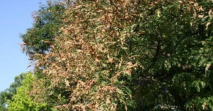Description: Mimosa webworm larvae are about one-inch long and light green to gray/brown with five longitudinal stripes on the body. The adult moths are silver-grey and have small black spots on the wings.
Life Cycle: There are two generations of Mimosa webworm each year. The firstgeneration moths emerge in early June and lay eggs on the honeylocust leaves. Caterpillars
can be seen from mid-June through early July. The second generation of moths appear
in mid to late July to lay another round of eggs. The larvae from this generation feed
from early to late August.
Damage: Though Mimosa webworms can defoliate trees, healthy, established trees
tend not to suffer greatly. Damage is primarily aesthetic as the larvae create tight webs
of silk around the leaflets. Foliage in the webs turns brown and is unsightly. Additionally,
the silk hanging from the trees as the larvae lower to the ground is a nuisance. 
Control: Chemical control is not typically necessary. Treatment is ineffective if applied this time of year when the webs and brown leaves are already present. For more information about Mimosa webworm visit: KSRE Publication Mimosa Webworm



